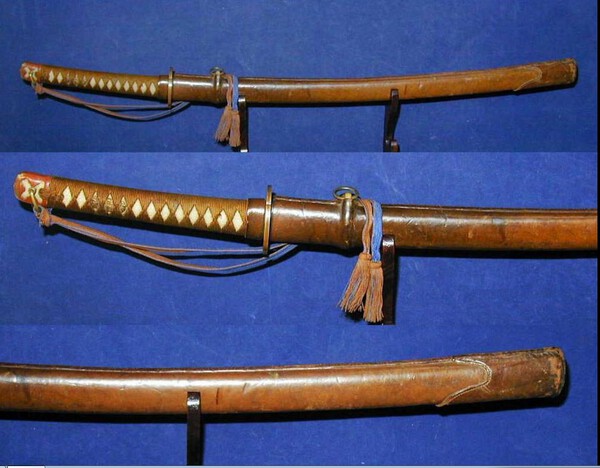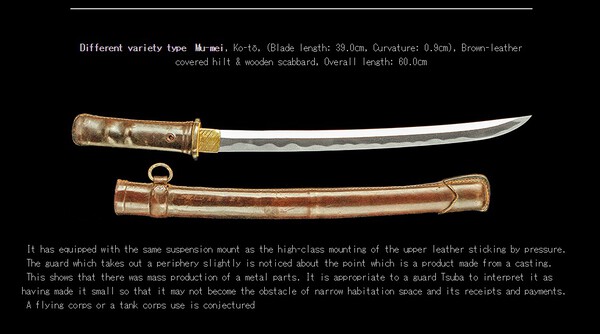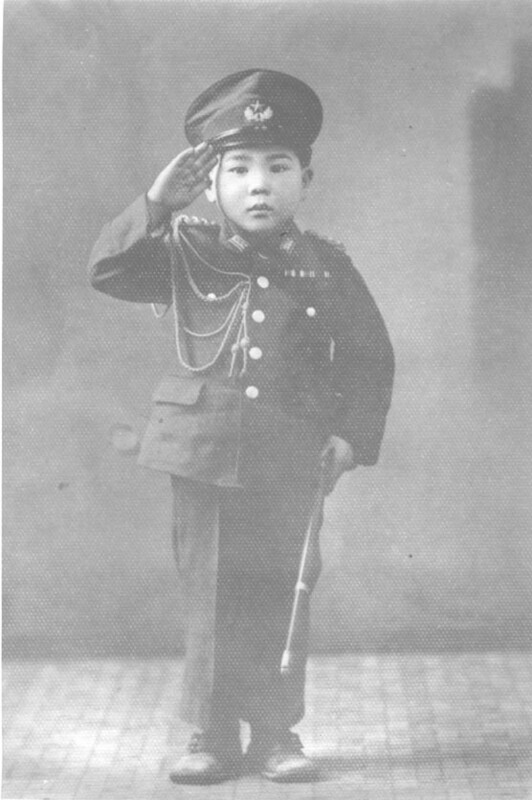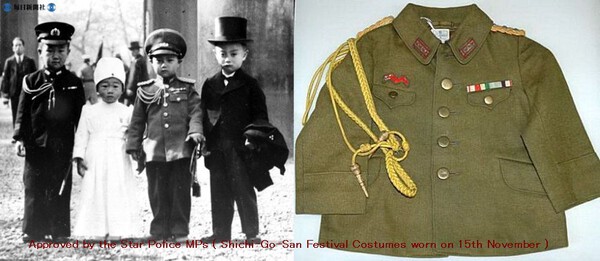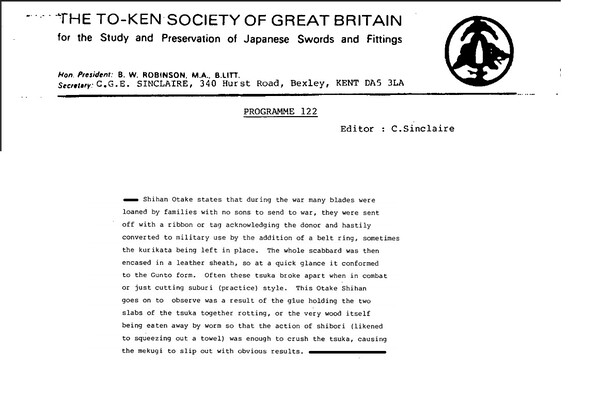-
Posts
1,686 -
Joined
-
Last visited
-
Days Won
12
Content Type
Profiles
Forums
Events
Store
Downloads
Gallery
Everything posted by Dave R
-
It would be interesting to see them in the hand, my experience with Chinese copies is that they fall down on details, or are even made of plated zinc alloy to pass as brass, copper or steel.
-

Has The Gunto Market Sky Rocketed Recently?
Dave R replied to RobertM's topic in Military Swords of Japan
As previously said, there are quite a few threads on various sites about the current rise in the price of Gunto, and a lot of ideas as to why it has happened. In the end, supply and demand rules apply, and one factor I think is the realisation that there are not as many of these about as people once thought! For myself I chased one down in order to own an example of the last sword seriously made as a combat weapon, as opposed to a wall hanger, sports equipment or Art object. -

Can Of Worms (Why Mantetsu-To Go So High)
Dave R replied to lonely panet's topic in Military Swords of Japan
There is a fair old discussion of a related topic over here. http://forums.gunboards.com/showthread.php?497553-Why-do-Japanese-Type-95-NCO-swords-get-more-money-than-officers-versions One of the things coming out is that all the Gunto are rarer than we used to believe, production numbers lower than thought and many of them destroyed during the occupation! I think the comment about a new coterie of buyers coming to the market is both interesting and valid. Over here in the UK they are paying big money for stuff related to their history and driving prices up on the market. -
There is a lot to like about that sword however it turns out with the mei.
-

Just Bought What I Believe Is A Kyu Gunto Need Id Help
Dave R replied to T14's topic in Military Swords of Japan
It is meant to be, and possibly is a Japanese naval shore patrol sword.... http://www.stewartsmilitaryantiques.com/Japanese-navy-police-officialshore-patrol-sword.21909.archive.htm -

Unknown Sageo And Tsukamaki
Dave R replied to kevinflores's topic in General Nihonto Related Discussion
I would also suggest looking up "Obijime", a lot of the same techniques are used in the production of these. Some of them make nice Sageo as they are. Personally I think they were both made by the same craftsmen, back in the day, and possibly still are. -

European Sword Fuller manufacture - it IS Nipponto related!
Dave R replied to Peter Bleed's topic in Nihonto
Were photo's posted and then lost? -

Help First Time Buyer And Post.. Wanted Your Opinons!
Dave R replied to Reddawn27's topic in Military Swords of Japan
After looking at the asking price, I am of the same opinion. These are priced at the high end for nothing special. Now if they were Mantetsu- Koa Ishin ................... -
Please can you post pictures of the whole sword. I have a particular interest in old blades mounted for use in WW2. Thank you.
-
Are these any good to you?.... http://www.amazon.com/Grobet-Swiss-Pattern-Pillar-Checkering/dp/B000H1U10G
-

Old Tsuka, Conservation Or Restoration
Dave R replied to Alex A's topic in General Nihonto Related Discussion
I think this is the one where you put the blade in a Shirasaya, and have a Tsunagi in the Koshirae, and display the one one above the other. -

Restoral Of Samurai Armor In London Video
Dave R replied to Gordon Sanders's topic in General Nihonto Related Discussion
For swords, go to the Royal Armouries Leeds. -
Thanks for this. I will have a dig through and see if I can find the original pictures.
-
Western Military protocol was that a sword was not sharpened until/unless the unit or individual was preparing to go into the field. Sharpening without orders was a chargeable offence, so at a guess blunt/unsharpened Gunto had been carried in Japan only, or never issued. A bit like not loading a pistol or rifle until you needed to use it.
-
Apologies to any recent followers of this thread for the disappearance of photo's that I posted. I am not sure what happened to them, but I suspect I hot-linked rather than uploading, I shall have to see if I can rectify it somehow.
-
Quote "Same day I met a polisher, I asked him to polish to 2 blades in the picture. While polishing the lower blade he noticed that the hamon went all around the kissaki, and also back around the cut away section. So this meant that the blade was forged as we see it, and the kissaki had not been re shaped. As he had never seen this before, he took it to another expert, this man is the curator of the Leeds Armoury, Japanese section. He said that the sword was indeed Koto, made in the muromachi period mid 16C by the Japanese sect who embraced the European culture, dressed as the European's and forged their sword's as they imagined the western swords would look like." So probably not Satsuma Age.
-

Yet Another Inherited Gunto Katana/wakizashi
Dave R replied to andym's topic in Military Swords of Japan
That type of saya would originally have had a leather cover, these do turn up on ebay from time to time at reasonable prices, so get one of them and forget the finish. It is unlikely that it would have been lacquer anyway, more likely ordinary paint and often they are bare wood under the cover. The leather tassel is an NCO's sword knot even though your sword is for a Commissioned officer, field replacement or a quick addition to make it more saleable back in the day? Regarding the blade, "Uchigo" it to death! Don't use abrasive paper or Brasso, I have heard talcum powder suggested as a cheap alternative for use on a beat up blade. I think the nakago needs a scrape with a piece of brass, copper or bone to remove the loose and active rust, and perhaps a light oil. I am sure others will have their own take on what to do. Originally it would have all looked something like this. Dave -

Yet Another Inherited Gunto Katana/wakizashi
Dave R replied to andym's topic in Military Swords of Japan
Thank you for posting the photos, that is one interesting sword. The extension to the saya and cover looks like a retro fit done after the sword had started in service. I am going by the way the "boot" is longer than normal with a brass ishizuki. Dave -

Yet Another Inherited Gunto Katana/wakizashi
Dave R replied to andym's topic in Military Swords of Japan
Do you have any photo's of this one. I wonder if it was a factory shortening due to a defect in manufacture? -

Not Bad Kai-Gunto On Craigslist
Dave R replied to Bruce Pennington's topic in Military Swords of Japan
Interesting that there are two mekugi-ana in a blade made in 1942, and not spaced out as they are on the "Type 3" for both to be used in the same mount. It hints at a re-mount within a short space of time.- 1 reply
-
- 1
-

-
For my part, I believe that there are/were "Crew Gunto" and that Mr. Ohmura shows them on his site here.... http://ohmura-study.net/977.html And most would look something like this.......
-
Oh well, I thought we were looking at possible origins of "so called pilot swords" in general! However here are some pictures of small Gunto in wear. Fred Lohman reckons that this is the origin of most of them.
-



